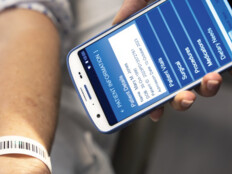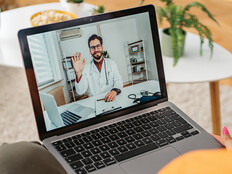To that point, ultraviolet light disinfectant systems are also a useful measure that healthcare environments should consider adopting for device sanitation purposes. In fact, a study published in the American Journal of Infection Control examined the effects of PurpleSun, a certain type of UV light technology, and determined the technology can eliminate up to 97.7 percent of pathogens in operating rooms alone.
Although UV light technology is not a replacement for other device hygiene measures, such as disinfection with chemicals, Donna Armellino, the lead author of the study and vice president of infection prevention at Northwell Health, tells Medical News Today that it can “optimize environmental cleanliness, resulting in decreased pathogens that could potentially cause infection.”
2. Adopt Touchless and Wireless Tools to Limit Exposure
One of the biggest trends emerging from the pandemic is the heightened demand for touchless technologies. With shared surfaces now being viewed as potential sources of contagion, companies that design and manufacture hands-free products are seeing a big spike in their sales inquiries.
One solution that’s taking off faster than others: temperature scanners.
The infrared camera devices, which can identify elevated skin temperatures without close contact, can be especially useful in healthcare settings. The technology is being used by organizations such as Memorial Hermann Health System at their points of entry to determine if a vendor, staff or patient family member might have a fever and require additional screening before being given access to the facility.
READ MORE: Learn how a "digital front door" can reduce foot traffic and streamline care.
Temperature scanners have also allowed the health system to stop manually scanning each individual’s body temperature at the facility entrances, saving their staff valuable time often spent on sanitation measures.
“In between each temperature, they had to sanitize the thermometers,” John Calhoun, a project manager for Memorial Hermann Health System, says in an interview with Texas Medical Center. “Just think about 1,000 people and the lines. The longer the line, the less likely that people are going to be 6 feet apart. We realized we had to improve the flow from a safety perspective.”
The entire process, which takes only a few seconds, is generally safer for staff and patients alike. Calhoun adds that the devices have also enabled employees, who had previously been tasked with taking temperatures manually, to return to their daily routine.
3. Ensure Quality Care Is Being Delivered Virtually
To further reduce the risk of viral transmission — not to mention conserve valuable time and personal protective equipment — CIOs should consider how their organization conducts care virtually from within its own walls.
Take virtual rounding for instance. This approach to care enables providers to see patients via digital screens outside the patient’s physical room in the facility.














